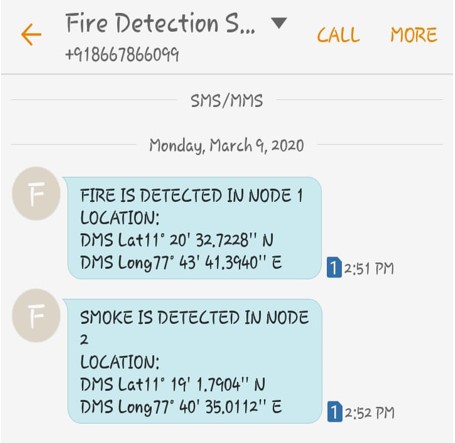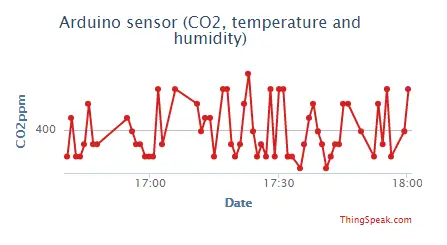A final year project on “Fire Detection in Forest Using Multiple Sensor Network Nodes″ submitted by G.Elango to extrudesign.com.
Forest fires are a recurrent phenomenon, natural or man-made, in many parts of the world. Vulnerable areas are mainly located in temperate climates where pluviometry is high enough to enable a significant level of vegetation, but summers are very hot and dry, creating a dangerous fuel load. The number and impact of forest fires are expected to grow as a consequence of global warming. In order to fight against these disasters, it is necessary to adopt a comprehensive, multifaceted approach that enables a continuous situational awareness and instant responsiveness.
The existing system uses single sensor node setup to detect and identify the fire. This reduced the overall success rate of fire detection and also covers lesser area.The existing system are also not internet connected to readily upload the data from sensor nodes to a server to monitor remotely.
In this work, Forest fire detection systems is a real-time monitoring system that detects the presence of fire and captures images via sensors and send the information to the monitoring centre, the particular predefined user. The key feature of the system is the ability to remotely send an alert to the server using Node MCU whenever a fire is detected. The system will also alert the user by using a GSM module. When the presence of smoke is detected, the system will display the live feed of the area under surveillance. The advantage of using this system is that it can detect early fire. The experiments are performed in a well-controlled real-time environment.
Keywords: Real-time monitoring system, Node MCU, Sensors, GSM module, Necessary actions.
INTRODUCTION
Human negligence or drastic environmental changes may lead to hazardous fires. Accidental fire is a major threat in various environments and may lead to potential loss of human lives and economic damage. The preservation of the natural surroundings is really essential. If fire can be detected at a proper time and necessary corrective measures are taken, then the fire disasters can be efficiently avoided. Fire accidents can take place in two different environments, such as indoor and outdoor environments. Indoor accidents include the buildings where fire occurs due to gas leakages, unattended equipment, heat source close to the combustibles, poor handling of sensitive materials, etc., whereas outdoor fire accidents involve forest fire, agricultural operations, natural factors, or deliberately setting fire in enmity, etc. Among these two, outdoor accidents are considered the most devastating accidents. Forest fire detection is an important task which has to be handled at early stages to avoid a huge loss. It is also very difficult to prevent fire in outdoor environments.
The fire detection system proposed in this paper integrates the use of multiple sensor network nodes, high accuracy and wireless communication. The system has lower power consumption and faster processing ability at a lower cost.
Each sensor node is equipped with a temperature sensor, smoke sensor and CO2 gas sensor. The temperature sensor senses the heat and smoke sensor senses any smoke generated due to burning or fire. Whenever fire triggered, it burns objects nearby and produces smoke. The CO2 sensor monitors the amount of carbon dioxide content in the surroundings. When a fire accident occurs it burns the carbon-based components and releases more amount of CO2 into the atmosphere. When the value of the sensors cross the threshold limit, an alert for the possibility of fire in the node location is sent to the authorities using GSM and the sensor data and location of fire accident possibility is updated in the web server using IoT.
Existing methods for Fire Detection in Forest
The existing system monitors air quality, temperature and humidity level of the surroundings. The micro-controllers like ARM processors, Atmega microcontrollers (Arduino), Peripheral Interference Controller (PIC) is used for processing the data from sensors and ZigBee, Bluetooth is used for wireless transmission for communication. Some of the drawbacks of the existing system are
- Existing systems use much complicated circuits and are more power-consuming.
- a forest fire can be detected, but the losses cannot be reduced due to lack of location known.
- There is no real-time system to pinpoint the location of the fire.
PROPOSED SYSTEM
In Proposed system, all the sensors are interfaced to the microcontroller and monitored using a single system. The temperature and humidity levels are monitored continuously with the help of sensors and in addition to this, the CO2 level of the surroundings is monitored simultaneously. The key feature of the system is the ability to remotely send an alert to the server using Node MCU whenever a fire is detected. The system will also alert the user by using a GSM module. When the presence of smoke is detected, the system will display the live feed of the area under surveillance. The advantage of using this system is that it can detect early fire. The experiments are performed in a well-controlled real-time environment.
SYSTEM DESIGN AND DEVELOPMENT
BLOCK DIAGRAM:

HARDWARE MODULES
1. Microcontroller (ATmega328 ):
ATmega328 is basically an Advanced Virtual RISC (AVR) microcontroller that supports the data up to 8 bits. ATmega328 has 32KB internal built-in memory. ATmega328 contains 1KB Electrically Erasable Programmable Read-Only Memory (EEPROM) and 2KB Static Random Access Memory (SRAM). Atmega328 has several different features consisting of advanced RISC architecture, good performance, low power consumption, programmable Serial USART, programming lock for software security etc. Atmega328 is mostly used in Arduino.

2. NodeMCU:
ESP8266 delivers highly integrated Wi-Fi SoC solution to meet the continuous demands for efficient power usage, compact design and reliable performance in the industry. With the complete and self-contained Wi-Fi networking capabilities, it can perform as either a standalone application or the slave to a host MCU. The integrated high-speed cache helps to increase the system performance and optimize the system memory. Also, ESP8266 can be applied to any micro-controller design as a Wi-Fi adaptor through SPI / I2C / UART interfaces.

3. Power Supply:
The proposed system contains batteries of 6V and 4.5aH. In the power supply circuit, batteries are accompanied with voltage regulators, rectifiers, and filters. Starting with an ac voltage, a steady dc voltage is obtained by rectifying the ac voltage, then filtering to a dc level, and finally, regulating to obtain a desired fixed dc voltage.
4. MQ-2 Gas sensor:
MQ2 gas sensor is an electronic sensor used for sensing the concentration of gases in the air such as LPG, propane, methane, hydrogen, alcohol, smoke and carbon monoxide. MQ2 gas sensor is also known as chemiresistor. It contains a sensing material whose resistance changes when it comes in contact with the gas. MQ2 is a metal oxide semiconductor type gas sensor. Concentrations of gas is measured using a voltage divider network present in the sensor. It can detect gases in the concentration of range 200 to 10000 ppm.

5. Temperature and humidity sensor
The DHT11 is a basic, ultra low-cost digital temperature and humidity sensor. It uses a capacitive humidity sensor and a thermistor to measure the surrounding air and spits out a digital signal on the data pin (no analogue input pins needed).
The only real downside of this sensor is we can only get new data from it once every 2 seconds, so when using our library, sensor readings can be up to 2 seconds old.

6. GSM module
SIM800 is a quad-band GSM/GPRS module that works on frequencies 850MHz GSM, 900MHz EGSM, 1800MHz DCS, and 1900MHz PCS.It also features GPRS multi-slot class 12/class 10 (optional), and supports CS-1, CS-2, CS-3, and CS-4 GPRS coding schemes.It has one UART port. It also has one USB port that can be used for updating firmware and for debugging.SIM800 operates on a supply in the range of 3.4 to 4.4V.

7. Flame sensor:
A Flame Sensor is a device that can be used to detect the presence of a fire source or any other bright light sources. There are several ways to implement a Flame Sensor but the module used in this project is an Infrared Radiation Sensitive Sensor. The accuracy of this sensor can be changed for the ease of usage.

8. Buzzer:
A buzzer or beeper is an audio signalling device, which may be mechanical, electromechanical or piezoelectric.


9. SOFTWARE
Arduino IDE – Source code IDE
IMPLEMENTATION RESULTS AND DISCUSSION
The hardware modules are connected together and the program is dumped into the hardware using Arduino IDE and verified the working of the system.

The implementation result of the proposed system is made to display in a smart phone application.


ADVANTAGES AND APPLICATIONS
ADVANTAGES:
- Minimal loss by multiple node setup
- area detection
- More reliable.
- Accuracy.
- effective.
APPLICATIONS:
- Real-time monitoring system.
- Provide data for analytics
- Identification and locating of forest fire accurately.
CONCLUSION AND FUTURE SCOPE
The IoT facility can be applied to wide range of applications. Real time forest fire monitoring system is based on IoT. An IoT module is connected to get the real time data so that the users can login and get data. Real time monitoring of pollution ensures that the rate of fire detection is maximum.The implementation cost is economical as the sensors and microcontrollers are easily available. The camera can be upgraded in future with image processing algorithms to enable a fully automated system for safety and wide area monitoring.. This enables to generate automated control in the absence of the authorized user.
ACKNOWLEDGMENT
Special thanks to our guide, coordinator and professors of Electronics and Communication Department, Velalar College of Engineering and technology for guidance, support and facilities extended to us.
REFERENCES
- T.Saikumar, P.Sriramya “Iot enabled forest fire detection and altering the authorites “, International journal of recent technology and engineering (IJRTE) ISSN:2277-3878, volume -7,Issuse-6S4,April 2019.
- Hariyawan M.Y.Gunawan A. Putra E.H. “wireless Sensor Network for Forest Fire Detection “, ISSN : 1693-6930,Vol.11,No.3,pp.563-574,September 2013
- Chaudhari. A.N., and Kulkarni. G.A. (2017), ‘IoT based Environmenal Pollution Monitoring System’ , IRJET. Vol. 04 , pp. 1823-1829.
- Khedo. K.K., Perseedoss. R., and Mungur. A. (2010), ‘A Wireless Sensor Network Air Pollution Monitoring System’ , IJWMN. Vol. 2 , No. 2., pp. 31-45.
- Chu. D.A., Kaufman. Y.J., Zibordi. G., Chern. J.D., Mao. J., Li. C., and Holben. B.N. (2003), ‘Global monitoring of air pollution over land from the Earth Observing System-Terra Moderate Resolution Imaging Spectroradiometer(MODIS)’. pp. 1-8.
- Deshpande. A., Pitale. P., and Sanap. S. (2016), ‘Industrial Automation Using Internet Of Things(IOT)’, IJARCET. Vol. 5, No. 2., pp. 266-269.
- Prof. Niranjan. M., Madhukar. N., Ashwini. A., Muddsar. J., and Saish. M. , ‘IOT Based Industrial Automation’, IOSR-JCE. pp. 36-40.
- Lavanya. M., Muthukannan. P., Bhargav. Y.S.S., and Suresh. V, ‘IoT Based Automated Temperature and Humidity Monitoring and Control’, JCPHS. pp. 86-88.
- Bauskar. P.A. and Prof. Pujari. K, (2016), ‘A Review on Industrial Automation Using IOT’, IRJET. Vol. 03, No. 12., pp. 1209-1212.
- Saha. H.N., Auddy. S., Chatterjee. A., Pal. S., Pandey. S., Singh. R., Singh. R., Sharan. P., Banarjee. S., Ghosh. D., and Maity. A. (2017), ‘Pollution Control using Internet of Things (IoT)’ , Vol. 10 ,pp. 65-68.

Leave a Reply